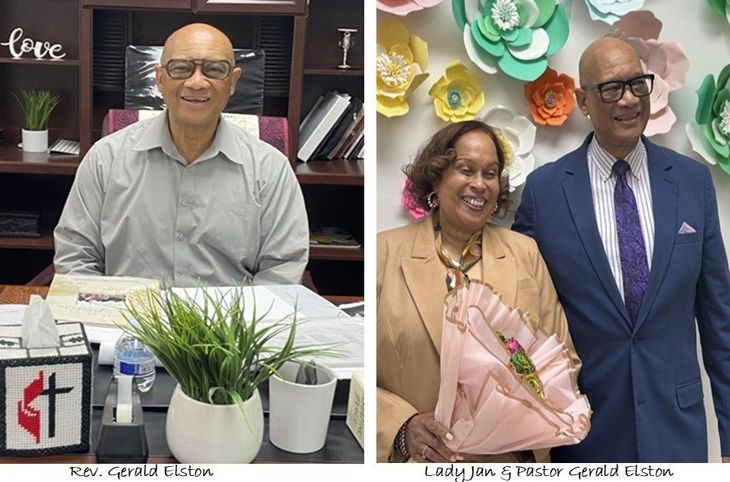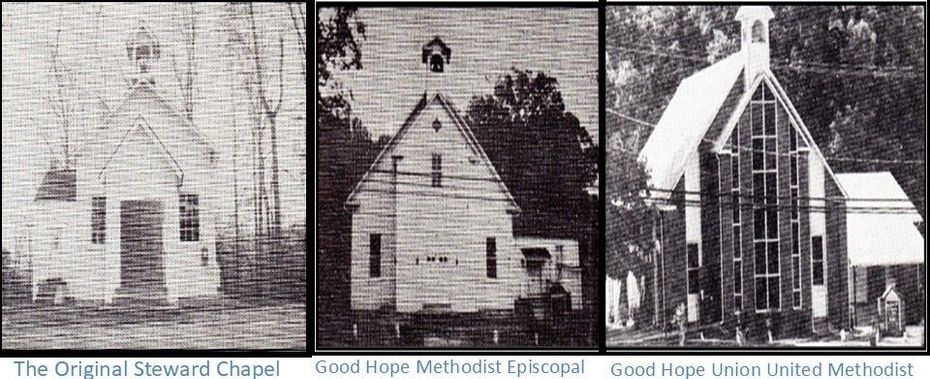Our History-Embracing the Present
(Click here for additional information concerning the Church and Cemetery across the street.)
With Faith in Our Hearts….…Look How Far We’ve Come

Good Hope Union United Methodist Church has been blessed for the past three plus years with this vibrant energy, family oriented Pastor, who together with his wife, our first lady Jan Elston have created a family driven atmosphere that spreads love and joy among members. Pastor Gerald believes we are a church who welcomes every village, meet needs, transforms lives, changes systems to love like Jesus. His vision is to take us to the next level, being missional and evangelistic-minded, we invite our community to address food insecurity, homeless/affordable housing,immigration,criminal and social justice, and creation care.
YET……. We Will Never Forget, How It All Begun
1870 - A group of freed farmers and small landowners purchased land from Sarah Watts, a black landowner. This land was situated on Good Hope Road, between New Hampshire and Briggs Chaney Road. John S. Powell, Tom Steward, and Sam Jones (Trustees at the time) signed the deed. The church was named Good Hope Methodist Episcopal. Good Hope Methodist Episcopal was associated with the Washington District/Washington Conference for colored Methodists on the Sandy Spring Circuit along with other area churches
1870-1881 – Pastors that served the circuit: Rev. Perkins, Rev. Harrison, Rev. Young, Rev. Lawson, Rev. Carol, and Rev. Thomas Brooks.
1882 – The Church graveyard was established
1888 - The Circuit was divided. Good Hope Methodist Episcopal and Steward Chapel became sister churches on the Colesville charge sharing one pastor.
1904 - Some members wanted a church close to home. The distance to Good Hope Methodist Episcopal was too far for them to walk. The church was built in the White Oak area and was named in honor of Thomas A. Steward who donated the land to the parishioners.

1913 - Under the pastorate of Rev. Howard Brooks Good Hope Methodist Episcopal built a new church with stained glass windows (donated by parishioners) and a bell tower. The new church replaced the old frame building which was destroyed by fire. Each Sunday Mr. Caleb Adams rang the bell to summon parishioners to worship
1918 - 1931 Pastors who served within the circuit include Rev. Benjamin Gross, Rev. Venture, Rev. Perry G. Myers, and Rev. Joseph Wheeler.
1925 – The first parsonage was built during the pastorate of Rev. Benjamin Gross. The Usher Board was organized by Mr. Caleb Adams. These Pastors accomplishments and their years of service to Good Hope Methodist Episcopal.
1932-1936 – Rev. John M. Bloom; 1937-1941 – Rev. Lanneau White; 1941-1946 – Rev. John R. Brooks; 1946-1954 – Rev. J.H. Holland; 1954-1958 - Rev. Thomas Reed.
1958-1960 Rev. Benjamin Hall. 1960-1964 Rev. I.G. Simpson; 1964-1968 Rev Julian O Grayson; 1968-1971 Rev. William Taft.
1937-1941 During pastorate of Rev. Lanneau L. White: Both churches were painted on the outside. Stewart’s Chapel was calcimined inside. A new ceiling has been put in Good Hope Church. The parsonage was renovated inside, and out and electric lights were installed. A new sanitary toilet has been built at the parsonage; new parsonage furniture purchased.
1937 - Men and Women Clubs (presently known as the United Methodist Men and United Methodist Women) were organized
1939 - The General Conference in Kansas City dropped the names Episcopal and Protestant. The church name was changed to Good Hope Methodist. The first choir was organized with Mr. Henry Boston as the Director, Mrs. Araminta Hansborough-Garner as the organist, Mrs. Josephine Davenport and Mrs. Mildred Campbell as assistants.
1946-1954 During the pastoral leadership of Rev. J. H. Holland two acres of additional land were purchased across the street from the church; church annex was built; heating plant installed.
1964-1968 A new parsonage was constructed during the pastoral leadership of Rev. Julian O. Grayson. The old parsonage which stood behind the newly constructed parsonage was torn down.
1967 Sister churches Good Hope Methodist Episcopal and Stewart’s Chapel Methodist merged and became Good Hope Union Methodist Church. Mr. John Sedgwick, member, was persistent and instrumental in the addition of the word ‘Union’ to the name of the church.
1968 The Methodist Church and the United Brethren Church became unified. From the unificationGood Hope Union became Good Hope Union United Methodist Church and a member of the Baltimore-Washington Annual Conference.
1968-1971 With Rev. William T. Norman as pastor the church paid off the mortgage for the parsonage.
1971-2005 Pastors appointed consecutively to Good Hope Union included: Rev. Dr. Emma P. Burrell.
1971-1981, Rev. Donald C. Adams 1981-1990, Rev. Douglas V. Logan 1990-1993, Rev. Burton Mack 1993-1996, Rev. John R. Brown 1996-2000, Rev. Dr. Ianther M. Mills 2000-2005, 1973 During the pastorate of Rev. Dr. Emma P. Burrell the church was remodeled, Paneled walls and carpets were installed. The entrance foyer was resurfaced; brick façade added to the outside; new pews were purchased through donated funds from members; new choir rail was installed; the heating system was changed, and air conditioning was added.
1981-1990 With the appointment of Rev. Donald C. Adams an additional room, referred to as the Sunday School room, and kitchen were added to the church.
1990-1993 Recognizing the need for transportation, during the appointment of Rev. Douglas V Logan the first church van was purchased. The church also received a sizeable bequeath from the estate of long-standing members, Patrick and Inez Brooks; Plans were put into motion to build a new church across the street. A building committee was formed.
1993-1996 Rev. Burton Mack continued the realization of a new church building. He led the building committee in the negotiation and purchase of an additional three (3) acres of land adjacent to the church’s seven (7) acres. He also guided the church into the information age of technology and implemented the use of computer technology to automate record-keeping for financial and membership information. Church members along with the Rev. Mack testified before the Park and Planning Commission of Montgomery County to secure permission to build a new edifice. Interviews of prospective architects were conducted. Community Day was also established. This was coordinated by Linwood Holland to engage the community in doing things together in fellowship with one another. A parade started the day with music, lots of food and games.
1996-2000 During the pastorate of Rev. John R. Brown Phase I of the building project was begun and completed. Paul Warner and Dustin Builders were selected as the architect and the construction company respectively. The ground-breaking ceremony for the new church was held in August 1997 and the construction of the new edifice began in July 1998. Congregation, friends, and dignitaries marched across the street singing the hymn “We’re Marching to Zion” as we entered the new facility November 1999.
2000-2005 Phase II of a building project was completed under the pastorate of Rev. Dr. Ianther M. Mills. This phase included a first-floor banquet hall, a commercial kitchen, and an upstairs area that can be completed for future growth. Several grants were secured from the conference to accomplish the following initiatives: the purchase of trees for reforestation required by the county to replace trees removed during the building process; purchased equipment and furnishings for a computer room; installation of satellite feeds for use by GHUUMC and other churches; the Good Hope Shalom Ministry, a nonprofit organization was established.
2005-2021 Pastors appointed consecutively to Good Hope Union and some of their accomplishments include: Rev. Jackie Jones Smith (2005-2012), Rev. Dr. Stacey Cole Wilson (2012-2016), Rev. Tori C. Butler (2016-2021).
2005-2012 The Church loan was refinanced to lower the interest rate and monthly mortgage payments during the appointment of Pastor Jackie Jones Smith; additional Bible studies formed including a weekly study via internet and webcam. Good Hope Union became active in community organizations influencing policies affecting county construction projects; Participated in Action in Montgomery, Habitat for Humanity and the Silver Spring Interfaith Housing Association. Young Adult choir, Anointed Praise was formed.
2012-2016 The church loan was again refinanced at a substantially lower interest rate during the appointment of Rev. Dr. Stacey Cole Wilson. The formation of community partnerships was initiated and small groups, notably the Couples Ministry, the Men’s Prayer group, Hear My Prayer, Global Ministries, to name a few, formed. Notable outreach efforts to make the surrounding community hunger free include the monthly free community meal as well as a grant funded free grocery give away began. Monitors were installed in the narthex and the sanctuary.
2016- 2021 Rev. Tori Butler was appointed as Pastor in July 2016. Earth Day was Instituted and sponsored by Comcast as a major cleaning event day for the church. This day was coordinated annually by Linwood Holland and Tee Shirts were given to all those who participated. This became an annual event. Among other accomplishments, a garden was developed and fenced by the Holland men. The first harvest produced greens such as kale and collards, tomatoes etc. were cooked and enjoyed by members. The church was shut down due to Covid, a health Crisis that swept throughout the nation.
July 1, 2021 – Present Good Hope Union United Methodist Church family continues to be blessed with an ongoing family team spirit. Rev. Gerald Elston was appointed Pastor and together with his wife Lady Jan Elston, they have created a family atmosphere with their ongoing love and support. Succeeded in reopening the church after restrictions for Covid were lifted. YouTube was installed as another means of social media, reaching out to the community and the world. Good Hope Union United Methodist Church is looking ahead and working towards the realization of Pastor Gerald’s vision that will take us to the next level.
